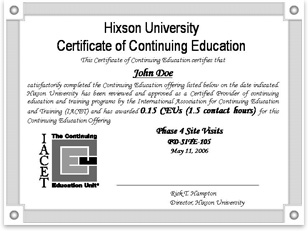
Back to School Summary: Cincinnati-based Hixson Architecture Engineering Interiors has an active in-house university that provides accredited professional continuing education credits authorized by the International Association for Continuing Education and Training, an organization whose accreditation is accepted by the AIA. Hixson University, established in 2001, follows a well-organized education structure of five colleges, each headed by a dean, with six curriculum tracks that serve more than 100 associates seeking technical and support training. Hixson University maintains its own records, helps associates earn credits for state licensure, and is the recipient of the 2003 Professional Services Management Association achievement award.
A support services group is also included in the structure. Different curricula are set up in six learning tracks that cross all five colleges:
University structure Developed by Hixson Senior Vice President and University Director Rick Hampton, Hixson University expands on many of the office learning strategies suggested by Marvin J. Malecha, FAIA, 2003 Topaz Medallion recipient, in his book The Learning Organization and the Evolution of Practice Academy Concepts. “We have taken it a little further,” declares Hampton. To that degree, the exemplary aspect of Hixson University is that it offers knowledge development to a large staff within a structured, organized capacity. “We had a learning program in existence, and its sole purpose was to make sure internal information was shared,” says Hampton, who himself developed the earlier program. “In 2000, we discovered that our learning format was ineffective. We wanted a system that could transfer information knowledge from the more-experienced people to the less-experienced people. We sanctioned a team that did studies and came back with the idea to set up a more formal, university-type format.” Cross-discipline learning Hixson’s continuing education courses offer certification and contact hours. Classes need to follow IACET guidelines, in particular, Hampton notes, incorporating the Bloom’s Taxonomy teaching method that increases difficulty levels of exercises to measure knowledge, comprehension, application, analysis, synthesis, and evaluation. “We felt that was the appropriate next step since professional licensing at the state level for architects and engineers accept IACET credits,” Hampton says,
Sharing knowledge |
||
Copyright 2006 The American Institute of Architects. All rights reserved. Home Page |
||
news headlines
practice
business
design
recent related
› Continuing Education Advances the Profession
› Ethics and the Educated AIA Architect
› Click here for information on the AIA Continuing Education System (CES).

 The Hixson firm combines architecture with engineering and focuses on the fashion retail, food and beverage, and pharmaceutical markets. The firm developed its university program following 20 years of an in-house training program. The university’s continuing education is composed of five colleges:
The Hixson firm combines architecture with engineering and focuses on the fashion retail, food and beverage, and pharmaceutical markets. The firm developed its university program following 20 years of an in-house training program. The university’s continuing education is composed of five colleges:

 Then there is a mandatory evaluation of learning, such as a test, panel discussion, or homework, as per IACET requirements. Hampton emphasizes that courses are well prepared and presented. “It’s not just: ‘We give you a test, now you are accredited’.”
Then there is a mandatory evaluation of learning, such as a test, panel discussion, or homework, as per IACET requirements. Hampton emphasizes that courses are well prepared and presented. “It’s not just: ‘We give you a test, now you are accredited’.”